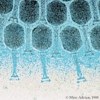It is possible to magnetize a baby with a few drops of water, some ordinary sugar and a teether. It’s all down to changes that take place in the brain when the baby tastes the sugar.
Neal Barnard MD, founder of the Physicians Committee for Responsible Medicine (PCRM), explains the process. Of course it’s not really magnetization, it’s the release of opiates in the brain, natural versions of morphine and heroin, that make us feel good. Barnard discusses the science underlying food addictions. Personal willpower is not necessarily to blame, chocolate, cheese, meat, and sugar all release these opioids. substances. Dr. Barnard also discusses how industry, aided by government, exploits these natural cravings, pushing us to eat more and more unhealthy foods. He suggests that a purely plant-based (vegan) diet is the solution to avoid many of these problems.
He points out how cheese and other dairy products contain natural compounds closely related to morphine, perhaps as a natural bonding chemical to ensure suckling mammals “enjoy” the suckling process. The presence of tiny quantities of these compounds in so many foods could explain why dairy products, chocolate, wheat, meat, nuts, onions, corn, tomatoes, onions, bananas, citrus fruits etc are common dietary triggers of migraine, for instance, users are simply overdosing on the opiates and then suffering withdrawal symptoms. And, as to cardiovascular disease, stroke, and heart attack…cardiologists know that if a man in his fifties presents with impotence, there is a one in four chance that he will have a heart attack or stroke within two years. Barnard blames our addiction to meat and even got cattle ranchers in the mid-west to prick up their ears when he relayed that fact and had them asking for his tofu recipes and tips on cooking brown rice.
Anyway, it’s a long video (40 minutes) but makes very interesting viewing.
 The latest, and potentially the greatest, in freely accessible chemistry database went live at midnight EST to coincide with the start of this year’s ACS Annual Meeting in Chicago. ChemSpider was built to aggregate and index chemical structures across the web together with their associated meta data and provide a single searchable repository available to everybody, for free. Structure identifiers such as SMILES, InChI, IUPAC and Index Names as well as numerous physicochemical properties are embedded with each database entry, of which there are 10 million at the moment. According to the site FAQ, “We intend ChemSpider to offer the fastest chemical structure searches available online and delivered with the flexibility and usability necessary to encourage repeat usage.” Chemists among the Sciencebase readership will no doubt already be clamouring to try out the beta release and to compare it with the likes of PubChem and ChEBI.
The latest, and potentially the greatest, in freely accessible chemistry database went live at midnight EST to coincide with the start of this year’s ACS Annual Meeting in Chicago. ChemSpider was built to aggregate and index chemical structures across the web together with their associated meta data and provide a single searchable repository available to everybody, for free. Structure identifiers such as SMILES, InChI, IUPAC and Index Names as well as numerous physicochemical properties are embedded with each database entry, of which there are 10 million at the moment. According to the site FAQ, “We intend ChemSpider to offer the fastest chemical structure searches available online and delivered with the flexibility and usability necessary to encourage repeat usage.” Chemists among the Sciencebase readership will no doubt already be clamouring to try out the beta release and to compare it with the likes of PubChem and ChEBI. The latest issue of Reactive Reports (#63) is now online featuring a selection of the hottest science news and our interview with the new Managing Director of the Royal Society of Chemistry, Dr Robert Parker.
The latest issue of Reactive Reports (#63) is now online featuring a selection of the hottest science news and our interview with the new Managing Director of the Royal Society of Chemistry, Dr Robert Parker. Mitch Garcia of UC Berkeley seems to be far more expert with the latest web 2.0 tool that lets you produce your own search algorithms than I, so I asked him to look into creating a Yahoo Pipe to allow anyone to search as many chemistry journals as possible that offer ASAP and in press papers online. And, much kudos to him, he has done just that. Here’s chemistry journals search pipe. He explains the process and the limitations in a little more detail on his own blog.
Mitch Garcia of UC Berkeley seems to be far more expert with the latest web 2.0 tool that lets you produce your own search algorithms than I, so I asked him to look into creating a Yahoo Pipe to allow anyone to search as many chemistry journals as possible that offer ASAP and in press papers online. And, much kudos to him, he has done just that. Here’s chemistry journals search pipe. He explains the process and the limitations in a little more detail on his own blog. Researchers have developed several tools to help them exploit the underlying chemistry of genomics, while novel chemistry has enabled faster, parallel sequencing methods that not only accelerate genomic research but also cut costs. The very same techniques allow sex chromosomes and complete genomes to be decoded faster and more cheaply than ever before.
Researchers have developed several tools to help them exploit the underlying chemistry of genomics, while novel chemistry has enabled faster, parallel sequencing methods that not only accelerate genomic research but also cut costs. The very same techniques allow sex chromosomes and complete genomes to be decoded faster and more cheaply than ever before. Solid state NMR is unlocking the secrets of compounds found in natural membranes from frogs’ legs to human lungs that could lead to an entirely new class of antibiotic drugs. The compounds in question are antimicrobial peptides (AMPs) and they have been detected in every living creature studied so far. AMPs act as a first line chemical defence system in a huge range of organisms and could provide a novel approach to defeating drugs resistance in bacteria.
Solid state NMR is unlocking the secrets of compounds found in natural membranes from frogs’ legs to human lungs that could lead to an entirely new class of antibiotic drugs. The compounds in question are antimicrobial peptides (AMPs) and they have been detected in every living creature studied so far. AMPs act as a first line chemical defence system in a huge range of organisms and could provide a novel approach to defeating drugs resistance in bacteria. Chemists go veggie
Chemists go veggie The faint glow from a single molecule combined with a stretch from “magnetic tweezers” could help scientists get a grip on how viruses that infect bacteria, so-called bacteriophages pack up their DNA. The research could lead to a resurgence of interest in the West for a potent treatment for infection that uses
The faint glow from a single molecule combined with a stretch from “magnetic tweezers” could help scientists get a grip on how viruses that infect bacteria, so-called bacteriophages pack up their DNA. The research could lead to a resurgence of interest in the West for a potent treatment for infection that uses